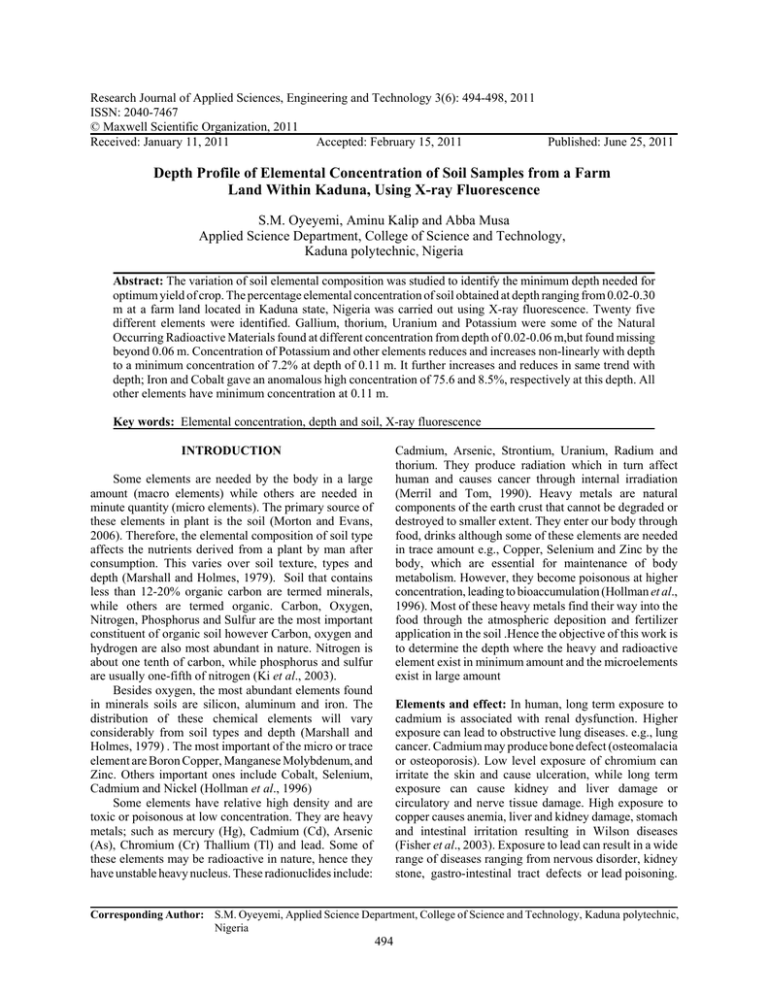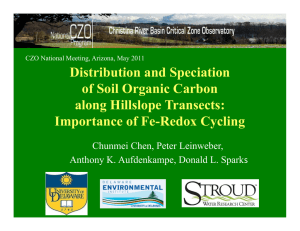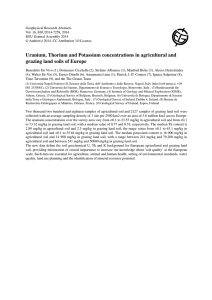Research Journal of Applied Sciences, Engineering and Technology 3(6): 494-498,... ISSN: 2040-7467 © Maxwell Scientific Organization, 2011
advertisement

Research Journal of Applied Sciences, Engineering and Technology 3(6): 494-498, 2011 ISSN: 2040-7467 © Maxwell Scientific Organization, 2011 Received: January 11, 2011 Accepted: February 15, 2011 Published: June 25, 2011 Depth Profile of Elemental Concentration of Soil Samples from a Farm Land Within Kaduna, Using X-ray Fluorescence S.M. Oyeyemi, Aminu Kalip and Abba Musa Applied Science Department, College of Science and Technology, Kaduna polytechnic, Nigeria Abstract: The variation of soil elemental composition was studied to identify the minimum depth needed for optimum yield of crop. The percentage elemental concentration of soil obtained at depth ranging from 0.02-0.30 m at a farm land located in Kaduna state, Nigeria was carried out using X-ray fluorescence. Twenty five different elements were identified. Gallium, thorium, Uranium and Potassium were some of the Natural Occurring Radioactive Materials found at different concentration from depth of 0.02-0.06 m,but found missing beyond 0.06 m. Concentration of Potassium and other elements reduces and increases non-linearly with depth to a minimum concentration of 7.2% at depth of 0.11 m. It further increases and reduces in same trend with depth; Iron and Cobalt gave an anomalous high concentration of 75.6 and 8.5%, respectively at this depth. All other elements have minimum concentration at 0.11 m. Key words: Elemental concentration, depth and soil, X-ray fluorescence Cadmium, Arsenic, Strontium, Uranium, Radium and thorium. They produce radiation which in turn affect human and causes cancer through internal irradiation (Merril and Tom, 1990). Heavy metals are natural components of the earth crust that cannot be degraded or destroyed to smaller extent. They enter our body through food, drinks although some of these elements are needed in trace amount e.g., Copper, Selenium and Zinc by the body, which are essential for maintenance of body metabolism. However, they become poisonous at higher concentration, leading to bioaccumulation (Hollman et al., 1996). Most of these heavy metals find their way into the food through the atmospheric deposition and fertilizer application in the soil .Hence the objective of this work is to determine the depth where the heavy and radioactive element exist in minimum amount and the microelements exist in large amount INTRODUCTION Some elements are needed by the body in a large amount (macro elements) while others are needed in minute quantity (micro elements). The primary source of these elements in plant is the soil (Morton and Evans, 2006). Therefore, the elemental composition of soil type affects the nutrients derived from a plant by man after consumption. This varies over soil texture, types and depth (Marshall and Holmes, 1979). Soil that contains less than 12-20% organic carbon are termed minerals, while others are termed organic. Carbon, Oxygen, Nitrogen, Phosphorus and Sulfur are the most important constituent of organic soil however Carbon, oxygen and hydrogen are also most abundant in nature. Nitrogen is about one tenth of carbon, while phosphorus and sulfur are usually one-fifth of nitrogen (Ki et al., 2003). Besides oxygen, the most abundant elements found in minerals soils are silicon, aluminum and iron. The distribution of these chemical elements will vary considerably from soil types and depth (Marshall and Holmes, 1979) . The most important of the micro or trace element are Boron Copper, Manganese Molybdenum, and Zinc. Others important ones include Cobalt, Selenium, Cadmium and Nickel (Hollman et al., 1996) Some elements have relative high density and are toxic or poisonous at low concentration. They are heavy metals; such as mercury (Hg), Cadmium (Cd), Arsenic (As), Chromium (Cr) Thallium (Tl) and lead. Some of these elements may be radioactive in nature, hence they have unstable heavy nucleus. These radionuclides include: Elements and effect: In human, long term exposure to cadmium is associated with renal dysfunction. Higher exposure can lead to obstructive lung diseases. e.g., lung cancer. Cadmium may produce bone defect (osteomalacia or osteoporosis). Low level exposure of chromium can irritate the skin and cause ulceration, while long term exposure can cause kidney and liver damage or circulatory and nerve tissue damage. High exposure to copper causes anemia, liver and kidney damage, stomach and intestinal irritation resulting in Wilson diseases (Fisher et al., 2003). Exposure to lead can result in a wide range of diseases ranging from nervous disorder, kidney stone, gastro-intestinal tract defects or lead poisoning. Corresponding Author: S.M. Oyeyemi, Applied Science Department, College of Science and Technology, Kaduna polytechnic, Nigeria 494 Res. J. Appl. Sci. Eng. Technol., 3(6): 494-498, 2011 Ii = I0 Ki Mi Di (Tang et al., 1986) Various methods can be used to determine the chemical composition of a material e.g., Atomic Absorption Spectrometer, Neutron Activation analysis and X ray florescence. However, this work involves the use of X-ray Flourescence. where, Io = Intensity of the primary beam of energy E0 Ii = Intensity of characteristic X ray Di = A correlation factor for attenuation of both the incident X rays and the characteristics X rays of element (i) in the sample. Ki = A factor that depends on the instrument set up and basic physical process e.g., geometry of the XRF spectrometer,attenuation of the exciting and characteristics radiation along the beam path and in the detector window., Mi is detector efficiency for radiation of energy Ei. X-ray Fluorescence (XRF): This is an analytical method used to determine the chemical composition of all kinds of material; the material could be solid, liquid, powered, filtered or other form (Funtua, 1999a). It could also be used to determine the thickness and composition of layers and coating. It is fast, accurate and non-destructive, usually requiring a minimal sample preparation. It finds applications in metal, cement, oil mining, and mineralogy and geology industries. XRF is also very useful in scientific research and pharmacy. Probability of producing a vacancy, fluorescent yield of element i. The amount of anlyte is written as: Theory of XRF: During X ray fluorescence, the atom of the sample is struck by high energy photons from a radioactive source, this energy is sufficient to cause ionization by removing electron out of the atom from K shell or L shall. A secondary characteristic X-ray is emitted when electron fills the vacancy created by an ejected electron, which gives the characteristics of the element. This characteristics X-ray is accompanied by continuous X-ray spectrum generated by electron in the X-ray tube having wavelength (8(m)). The XRF measure this fluorescence electron (Funtua, 1999b). Mi = Wi m where, Wi = Weight fraction Mi = Mass thickness of element i in the sample. Unit (g/cm3) Di = Attenuation correction is given as. Di = I - exp[ (u(E0) Cos (Ø1 + u (E1) Cos Ø2m)] [(u (E0) Cos Ø1 + u (E1) Cos Ø2)]m (Markowicz, 1979) The maximum energy of exciting electron is given by Duane-hunt law as: 7v = hc/eV0 where, u(E0) and U(E1) are the mass attenuation Coefficient, for the exciting and characteristic radiation of energies E0 and E1, respectively. This can be express as weighted sum of individual mass attenuation coefficient for all elements in the sample. Ø1 is the glancing angle between exciting radiation and the sample plane. Ø2 is the glancing angle between the characteristic radiation and the sample plane. (1) where, h = planks constant, C = velocity of light, e = electronic charge, V0 = potential different applied to the tube. Energy = e V0 For thin samples: The fluorescence yield is given as: where, m =.> o, Di = 1 Wk = N(Xk) / N0 (Angeyo et al., 1998) Therefore the equation become: where, N(Xk) is the number of emitted Xk rays? N0 is the number of K vacancy for particular energy (peak intensity) is rated to the amount of analyte in the sample. The quantitative evaluation of elemental concentration in Energy Dependent X-ray Fluorescence (EDXR) depends on type of sources (either monochromatic or contain range of energies). The relationship between mass thickness or area density (Mi) of a specific element and measured intensity Li of it characteristic X ray peak is: I1 = l0 Ki Mi = Ii Ki Wi M For infinity thick sample m à infinity Therefore Di = 1 M [u (E0) Cos Ø1 + u (E1) cos (Ø2)] and Ii = 495 Io Ki Wi [(U (E0) Cos Øi + U (Ei) Cos Ø2)] (Leroux and Mahmoud, 1996) Res. J. Appl. Sci. Eng. Technol., 3(6): 494-498, 2011 Table 1: Depth profile of elemental percentage concentration Depth(cm) Ca K Sc Ti V 2.00E+00 8.64E+00 9.21E+00 4.25E+00 3.86E+00 1.51E+00 4.00E+00 8.91E+00 9.79E+00 4.47E+00 3.16E+00 1.81E+00 6.00E+00 1.01E+01 9.08E+00 6.08E+00 4.78E+00 1.85E+00 8.00E+00 7.61E+00 8.71E+00 4.21E+00 3.45E+00 1.50E+00 1.10E+01 5.45E+00 7.21E+00 0.00E+00 2.09E+00 8.01E-01 1.40E+01 9.09E+00 1.02E+01 0.00E+00 3.92E+00 1.72E+00 1.80E+01 9.10E+00 1.04E+01 0.00E+00 3.94E+00 1.49E+00 2.20E+01 9.05E+00 1.08E+01 0.00E+00 2.55E+00 1.52E+00 2.50E+01 1.18E+01 1.44E+01 0.00E+00 4.03E+00 1.38E+00 3.00E+01 8.46E+00 1.35E+01 0.00E+00 3.13E+00 1.37E+00 Depth(cm) Co Ni Cu Zn W 2.00E+00 4.13E-01 3.29E-01 2.22E-01 1.99E-01 4.26E-01 4.00E+00 5.82E-01 2.84E-01 2.29E-01 1.44E-01 4.22E-01 6.00E+00 4.60E-01 3.05E-01 3.20E-01 1.54E-01 3.40E-01 8.00E+00 3.95E-01 3.94E-01 2.75E-01 1.41E-01 3.07E-01 1.10E+01 8.49E-01 8.72E-01 4.93E-01 3.34E-01 0.00E+00 1.40E+01 3.52E-01 3.41E-01 2.07E-01 1.40E-01 0.00E+00 1.80E+01 3.23E-01 2.73E-01 1.82E-01 1.20E-01 2.20E+01 4.38E-01 3.75E-01 3.27E-01 2.21E-01 2.50E+01 3.90E-01 3.97E-01 2.86E-01 2.25E-01 3.00E+01 3.86E-01 2.85E-01 2.12E-01 1.32E-01 Depth(cm) Br Rb Sr Th Y U 2.00E+00 4.40E-02 3.10E-02 2.69E-02 5.33E-02 2.88E-02 4.37E-02 4.00E+00 4.90E-02 3.10E-02 2.58E-02 4.64E-02 4.78E-02 4.22E-02 6.00E+00 4.40E-02 3.12E-02 3.04E-02 1.04E-02 3.12E-02 5.14E-02 8.00E+00 3.60E-02 2.93E-02 2.42E-02 4.67E-02 2.79E-02 3.79E-02 1.10E+01 8.30E-02 6.34E-02 4.78E-02 0.00E+00 5.11E-02 1.40E+01 3.60E-02 3.36E-02 2.39E-02 2.10E-02 1.80E+01 3.70E-02 3.13E-02 2.50E-02 4.48E-02 2.20E+01 4.30E-02 3.78E-02 4.15E-02 2.64E-02 2.50E+01 4.70E-02 3.60E-02 3.62E-02 3.78E-02 3.00E+01 3.50E-02 2.47E-02 2.20E-02 2.03E-02 cr 1.14E+00 1.31E+00 1.17E+00 9.46E-01 6.37E-01 1.02E+00 1.21E+00 8.14E-01 9.02E-01 8.46E-01 As 1.21E-01 9.80E-02 1.07E-01 9.50E-02 2.10E-01 1.02E-01 1.03E-01 1.67E-01 1.29E-01 8.60E-02 Zr 1.39E-01 1.98E-01 2.71E-01 2.01E-01 1.96E-01 1.96E-01 1.64E-02 1.86E-02 2.38E-01 1.77E-01 mn 6.77E-01 7.97E-01 7.95E-01 7.38E-01 5.91E-01 9.74E-01 6.95E-01 7.77E-01 7.36E-01 6.60E-01 Ga 1.28E-01 1.30E-01 1.73E-01 1.14E-01 Nb 1.59E-02 1.65E-02 1.54E-02 1.31E-02 2.46E-02 1.27E-02 1.14E-02 1.48E-02 1.78E-02 1.41E-02 fe 1.24E+01 7.06E+00 9.31E+00 1.08E+01 7.56E+01 1.01E+01 7.69E+00 2.77E+01 2.48E+01 1.26E+01 Pb 1.68E-01 1.40E-01 1.51E-01 1.60E-01 3.00E-01 1.51E-01 1.44E-01 2.25E-01 1.81E-01 1.24E-01 Mo 1.36E-02 1.26E-02 1.42E-02 1.21E-02 3.20E-02 1.19E-02 1.07E-02 1.50E-02 1.57E-02 1.06E-02 various depth ,with different percentage composition as shown in Table 1. The counting rates for all detectable elements within a sample are usually calculated by counting for a set time. The numbers of photon that are detected for various analytes “characteristics” X-ray energy lines are noted. Therefore by determining the energy of X-ray peak in a sample spectrum and by calculating the count rate of various elemental peaks, it is possible to quantitatively establish the elemental composition of the sample and to quantitatively measure the concentration of these elements. (www.rigakumsc.com). In EDXRF, the area of the peak gives the intensities while in WDXRF the height of the peak gives the intensity (Peter, 2003) RESULTS AND DISCUSSION Figure 1 shows Twenty five different elements identified at depth ranging from 2.00E+00-3.00E+01 cm, with non linear elemental concentration variation with depth .However all the identified elements shows reduction in concentration with depth reaching a minimum concentration at 1.10E+01 cm, except Iron which shows an anomalous high concentration at this depth .Other elements shows similar variation with depth. Zinc has the least concentration at all depth. 0.3% of lead was found at depth 1.10E+01 cm. Soil often contains 1-5% of iron in the flow layer, they occur in the silicate minerals or iron oxide and hydroxides that are readily available for plants. They are responsible for the reddish and yellowish colour of the soil. Iron is indirectly responsible for the green colour of growing plants, because it helps in the production of chlorophyll. Organic matter also improves the iron availability thereby reducing chemical fixation or Precipitation of iron as ferric hydroxide, hence resulting in higher concentration of iron. Organic minerals are also source of iron in the soil.. Livestock manure and fertilizer contains iron depending on source and types respectively, especially Ferrons sulphate fertilizer (Shulte, 2004). MATERIALS AND METHODS Ten soil samples were collected from a farm within Kaduna state in Nigeria at various depths, ranging from 0.02-0.30 m. The work was carried out between August and September 2008. The elemental composition was analyzed using XRF techniques. The procedure for sample preparation was followed as described by (Tang et al., 1986). Energy dispersive X ray fluorescence (EDXRF) spectroscopy with an isotropic source was used for the sample analysis. An Annular Zinc Cadmium 109 was used as the excitation source that emits Ag - K, X-ray at 22.1 KeV. A Si (Li) detector with resolution of 170eV for 5.90 KeV was used to detect the emitted radiation. Twenty five elements were identified at 496 Res. J. Appl. Sci. Eng. Technol., 3(6): 494-498, 2011 Fig. 1: Elemental depth profile Fisher, N.D.L., M. Hughes, M. Gerhard-Herman and N.K. Hollenberg, 2003. Flavanol-rich Plants induces nitric oxide- dependent vasodilatation in healthy humans. J. Hypertention, 21(12): 2281-2286. Funtua, I.I., 1999a. Analysis of Nb-Ta by energy dispersive X-ray fluorescence Spectrometry. J. Trace Microbes, pp: 189-195. Funtua, I.I., 1999b. Application of the transmission emission method in EDXRF for determination of trace elements in geological and biological materials. J. Trace Microbes, pp: 293-295. Hollman, P.C., M.G.L. Hertog and M.B. Kantan, 1996. Role of dietary flavonoids in protection against cancer and coronary heart disease. Biochem. Soc. Transact., 24: 785-789. Ki, W.L., J.K. Young, J.L. Hyong and Y.L. Chang, 2003. Phenolic Phytochemicals and Higher antioxidant. J. Agric. Food Chem., 51(25): 7292-7295. Leroux, J. and M. Mahmoud, 1996. X-ray Qualitative analysis by an emission transmission method. Anal. Chem., 38: 76-82. Markowicz, A.A., 1979. A method for correction for adsorption, matrix effect in sample of intermediate thickness in EDXRF analysis. X-ray Spectrum. 8: 14-18. Marshall, T.J. and J.W. Holmes, 1979. Soil Physics. Cambridge University Press, New York. CONCLUSION Seeds and Vegetables planted at 11cm depth on this soil will have high concentration of iron. This is as a result of rain water that leach basic nutrients such as calcium and magnesium from the soil top. They are often replaced by acidic elements such as aluminum and Iron. The absence of Aluminum on this soil sample could be responsible for anomalous concentration of iron. Plants likely to be grown and germinated on this soil include potatoes and strawberry, they require slightly acidic soil. Soil bacteria prefer this optimum range of pH level of 6.36.8, and they are often affected by fertilizer; there by increasing the uptake of nutrients by plants (Shulte, 2004). The high concentration of iron at 11 cm could be as a result of leached of rain water and the use of Ferron sulphate fertilizer for planting on the farmland. We suggest the planting of seeds of any kinds beyond 12 cm depth for better yield and proper use of soil nutrients for healthy growth. REFERENCES Angeyo, K.H., J.P. Patu, J.M. Mangala and D.G.S. Naraya, 1998. Optimization of x-ray fluorescence elemental analysis. Appl. Radiat. Isot., 49: 885-891. 497 Res. J. Appl. Sci. Eng. Technol., 3(6): 494-498, 2011 Tang, S.M., P. Kump, C.T. Yap and M.G. Bilad, 1986. Calculation of relative Fluorescence intensity for annual source geometry by monte carlo method. Xray Spectrum, pp: 289-293. Shulte, E.E., 2004. Understanding Plants Nutrients. Soil and Applied Iron A3554. Cooperate Extention Publication, University of Wincoustin Extension. Merril, E. and G. Tom, 1990. Enviromental Radioactivity from Natural, Industrial and Military Sources. Academic Press Inc., 4th Edn., pp: 94-95. Morton, L.S. and C.V. Evans, 2006. Soil Radioactivity and Soil Survey. 2nd Edn., Saruders Publishing, UK, pp: 118-120. Peter, B., 2003. Theory of XRF. 1st Edn., Panalytical BV, Netherland. 498


